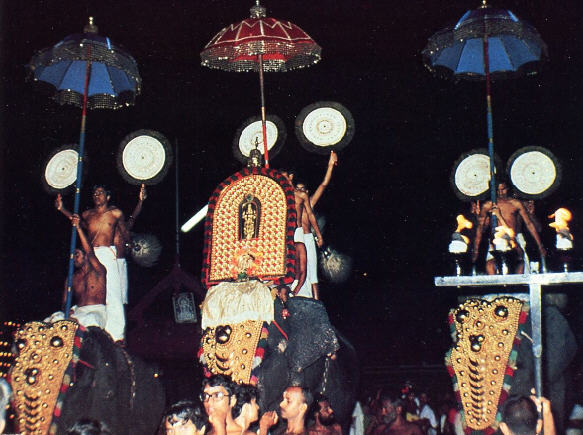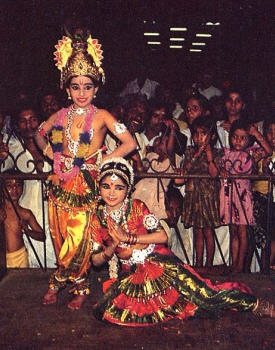Where Heaven Meets Earth
Grand processions in an atmosphere of devotion draw crowds
of eager pilgrims to an ancient South Indian temple.

Many factors contribute to the popularity of India's major temples. Sri Rangam, situated on the Kaveri River, is popular because of its antiquity. Badarinatha, high in the Himalayas, is famous for its geographical location. Konark, the sun temple in Orissa, is known for its unique architecture, and Vyenkatesvara, in the South Indian hill town of Tirumala, owes much of its fame to the Deity's reputation for fulfilling the requests of His worshipers. All these factors combine at Guruvayur, in the South Indian state of Kerala. Guruvayur is one of the most enchanting and glorious temples in all of India.
There are no movie theaters in the town of Guruvayur. No liquor stores. Nor night clubs. Guruvayur is a holy city, where people come to make spiritual advancement. In an atmosphere of devotion to Krsna, visitors immediately feel they have risen above this earthly world to the divine. Appropriately, Guruvayur is known as Bhuloka Vaikuntha: "where heaven meets earth."
A visit to Guruvayur, though common to devotees in India, is something very few Westerners have experienced. To witness the thousands of devoted pilgrims who come to worship Krsna every day is astounding. The faith of the pilgrims who visit Guruvayur is expressed in their earnest and sincere faces as they enter the temple. While sitting in the large open-air corridor outside the Deity's chamber, pilgrims hear priests tell about the many miracles performed at Guruvayur. With palms joined in awe and nee, the devotees pray that they too might receive the blessings of Lord Krsna.
The temple schedule begins at 3 A.M. with darsana (seeing the Deity), followed by abhiseka (bathing the Deity), and continues until 10 P.M., when the Deity takes rest for the night. Throughout the day the elaborate worship of the Deity of Lord Krsna engages the temple priests and thousands of visitors in activities of Krsna consciousness. Accompanied by music and singing, the devotees daily offer hundreds of vegetarian dishes, colorful silks and other items of opulent clothing, jeweled ornaments, garlands of flowers, and even elephants as gifts to the Deity.
During the mid-morning hours many wedding ceremonies take place, one after another. Devoted couples, believing that being married at the Guruvayur temple is a great blessing, come here from all over South India.
In the evening, varieties of classical dance, such as Bharata-natyam and Kathakali, are performed for the public. The dancers combine dance and drama to depict the pastimes of Lord Krsna. These dance traditions have existed in South India for thousands of years, and no temple function is complete without them.
The evening also brings the main event of the day: a Deity procession led by jewel- and gold-bedecked elephants. The beauty of the Deity and the grandeur of the elephants draws thousands of pilgrims to witness the procession each evening. Before the arrival of the Deity, elaborate preparations are made. Then, as the enthusiastic crowd stands expectant, a devotee blows three blasts on a conchshell. The priests quickly emerge from the Deity's chamber bearing Lord Krsna on a golden throne, which is placed on the lead elephant. Surrounded by priests bearing multicolored umbrellas and varieties of fans, by musicians playing drums, cymbals, gongs, and trumpets, and by exuberant devotees chanting the names of the Lord, the Deity is carried around the temple compound, now illuminated by ten thousand oil lamps.

After about one hour, with the circumambulation completed, the elephants return to the starting point and stand motionless while the Deity is removed from the golden throne and returned to His chamber. It is now 10 p.m., and the temple closes for the night.
Because the elephant procession is held every night of the year, the Guruvayur temple owns an elephant ranch, where thirty-six elephants are trained to perform ceremonial functions. In the history of the temple several elephants stand out as special. One of the most famous was Kesava, also know as Gajaraja, or "king of the elephants."
Kesava's unique devotion for his service at Guruvayur will not soon be forgotten. When Kesava became the leading elephant in the temple herd, he would no longer tolerate another elephant's carrying the Deity. Once, when another elephant was selected to carry the Deity in procession, Kesava became so disturbed that he attacked the other elephant and chased him away. Whenever Kesava was to carry the Deity, he would demonstrate his great eagerness to perform his service by pulling at the chains that bound his feet.
For more than fifty years Kesava served Lord Krsna at Guruvayur. During one festival, however, he became ill, just at the time of the Deity procession. His huge body began to tremble, and he was removed from the procession and taken to a nearby stable, where he fasted throughout the night. The next evening, when the conchshell blew to announce the appearance of the Deity, Kesava bowed before the temple, and amid thousands of devotees chanting and playing on musical instruments, his soul departed from his body to attain the eternal realm of Vaikuntha.
When pilgrims arrive at Guruvayur, they are reminded of Kesava by his tusks and portrait displayed above the main entrance to the Deity chamber. And throughout the city many shops sell colorful paintings of Kesava.
At Guruvayur, whether on the days of great festivals or in the moments before the evening procession, when ten thousand oil lamps are being lit, or while hearing about Kesava, the king of the elephants, the pilgrim naturally feels a growing desire to glorify the Supreme Personality of Godhead, Lord Krsna.
